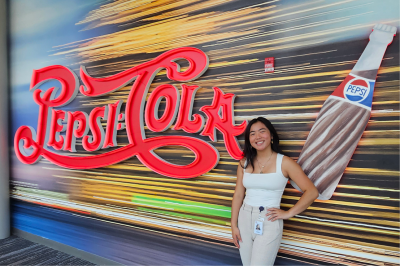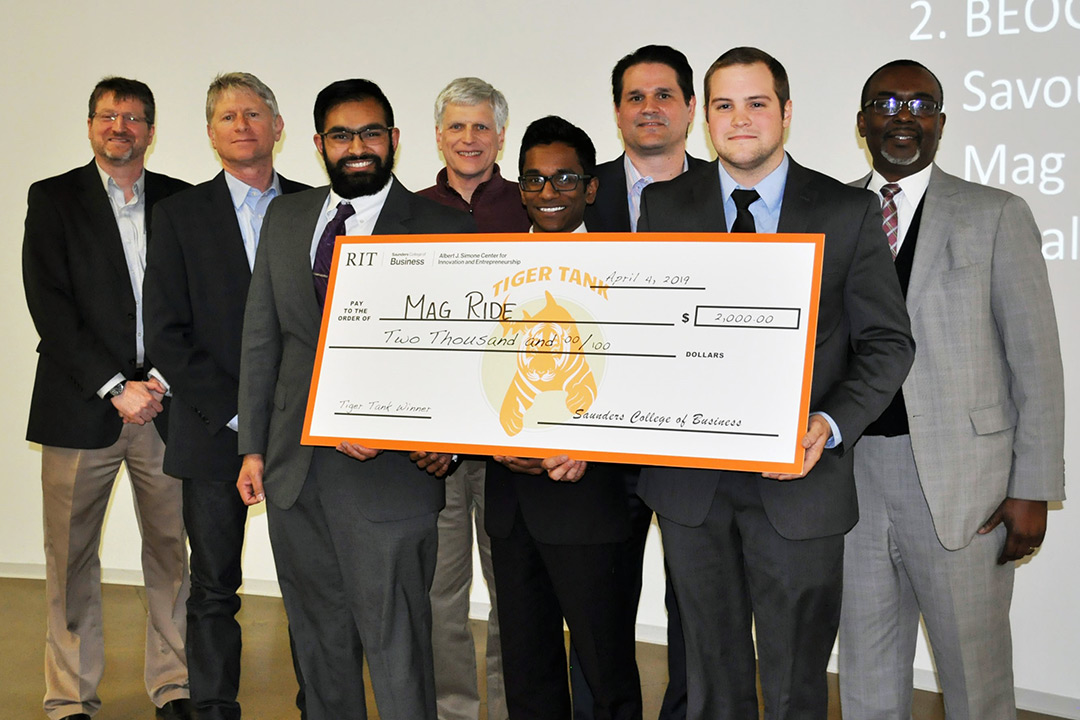Innovative suspension system for off-road vehicles takes top spot in spring Tiger Tank competition
Team will now work on next steps: raising capital, marketing, distribution
Taylor Thum
The student team from “Mag Ride” took first place in the Tiger Tank finals, sponsored by RIT’s Saunders College of Business and hosted by the Simone Center for Innovation and Entrepreneurship. Mag Ride is a magnetic coil piston that will improve suspension systems in on- and off-road vehicles. Pictured in front, from left to right, are students Kishoth Manoranjithan, Asif Habib and Forrest Sheard. In back, from left to right, are Richard DeMartino, Simone Center director, and judges Ed Bizari ’85 ’95 (electrical engineering, MBA), consultant, instructor and entrepreneur-in-residence at Launch NY; David Chauncey ’86 (electrical engineering), managing member of Echo Bay Ventures; Kurt Phelps ’95 (mechanical engineering), founder of Global Network Recruiting and Phello; and Randy Henderson, president of Henderson Ford and former RIT Minett Professor.
A uniquely designed magnetic coil piston that will improve suspension systems in on- and off-road vehicles took first place in Rochester Institute of Technology’s semi-annual Tiger Tank entrepreneurship competition.
Sponsored by RIT’s Saunders College of Business and hosted by RIT’s Simone Center for Innovation and Entrepreneurship, Tiger Tank gives students the opportunity to pitch a business idea to a panel of judges with a chance to win cash prizes. Teams competed to win $4,750 in cash prizes as well as scholarships for graduate studies at RIT’s Saunders College of Business.
The students behind the winning product design—Forrest Sheard, a fifth-year electrical engineering technology major from Boyds Mills, Pa.; Asif Habib, a fourth-year mechanical engineering technology major from Pittsford, N.Y.; and Kishoth Manoranjithan, a third-year mechanical engineering technology major from Hollis, N.Y. —created “Mag Ride” using the properties of magnetorheological (MR) fluid to vary the damping characteristics in suspension systems. According to the students, the system features a unique magnetic coil piston that they designed, as well as hand-mixed fluids used to minimize vehicle instability. The students are hoping Mag Ride will be used by consumers in the performance on- and off-road vehicle market because of its low cost, low power consumption and overall improved performance over products currently on the market.
The Tiger Tank competitors were required to present to the judges a problem, venture or business that it seeks to solve or gap in the marketplace it seeks to fill; a description of the target market; what value the venture would add to lives; and potential challenges to delivering the product or service. Proposals were evaluated based upon their uniqueness, feasibility and the ability to impact people.
The four other teams that competed in this year’s Tiger Tank finals were:
- Local Sports: A social media platform and user interface that allows amateur athletes to easily organize and participate in tournaments and leagues. The platform can also track game results and player statistics and allows players to stream videos of live and past games.
- BEOGo: A software tool for military personnel that allows them to visually plan for energy needs on training assignments and missions. The software can also be adapted to humanitarian and non-governmental organizations for use in war zones, driving down costs associated with energy logistics operations and planning.
- Savourit: Plastic food storage containers that react to bacteria exposure. Lids change color based on the amount of bacteria inside the container. The container changes back to its original color after food is consumed or discarded and the container is washed.
- Calendar Scanner: The app is able to transfer a photo of a Word document containing information about events to a user’s Google calendar. The app can organize a to-do list and minimizes the probability of errors when entering calendar information.
The five finalists were selected from 35 student teams representing a variety of academic disciplines that competed in the semifinal round.






